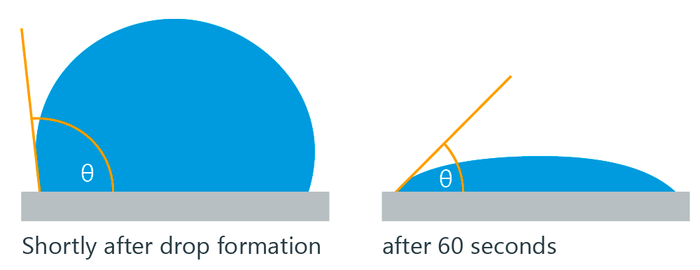Static contact angle
The static contact angle is the contact angle with which the contact area between liquid and solid is not changed from the outside during the measurement, in contrast to the dynamic contact angle which is produced in the course of wetting (advancing angle) or de-wetting (receding angle).
Background
A pure liquid in the saturated vapor phase forms the Young contact angle on an ideal, chemically and topologically homogeneous solid as described by Young's equation. In this case, the static and dynamic contact angles would be equal.
With real solids, liquids and ambient conditions, the contact angle can vary as a function of time and location. Inhomogeneities and changes of wetting over time can therefore be detected by means of the static contact angle.

If, on the other hand, the effect of location and time is to be minimized, then the advancing angle is usually measured.
A further criterion for deciding between static and dynamic contact angle is the technical wetting process observed. Dynamic processes, such as coating, are better modelled by means of dynamic measurements. Static contact angles are often more meaningful for assessing quasi-static processes, e.g. bonding in semiconductor technology.
Measuring methods
- Drop shape analysis on sessile drops: Analysis of the image of a sessile drop deposited on a solid.
- Captive bubble method: Analysis of the image of an air bubble in a liquid beneath a solid.
- Top-view distance method: The curvature of the drop surface associated with the contact angle is measured using the distance between light spots which are reflected on the top of a drop surface.




